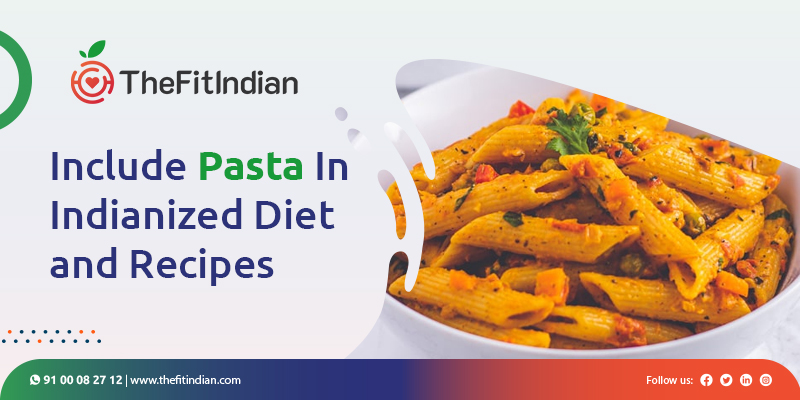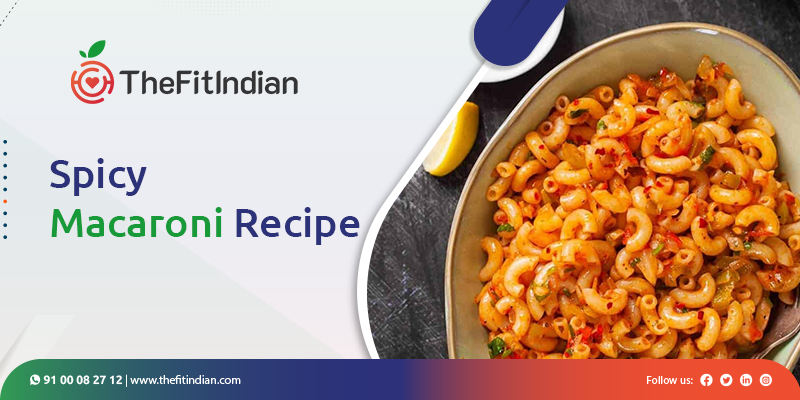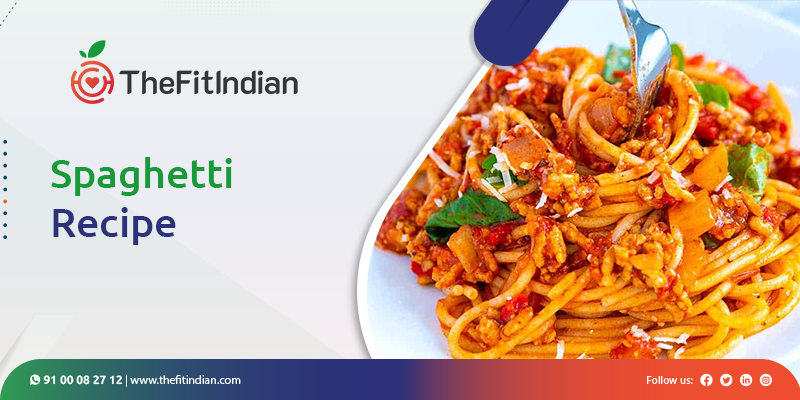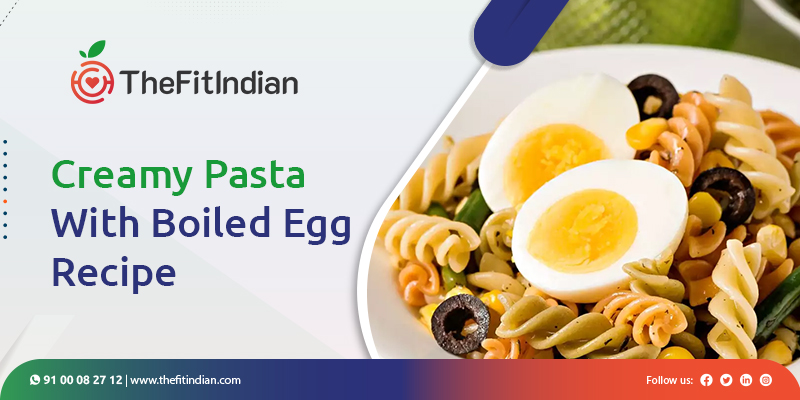Top Reasons To Include Pasta In Indianized Diet and Recipes
Reviewed by: Dr. T S Deepthi Sarojini | Author: Manoja Kalakanti
Comfort foods frequently have a bad rep. You naturally believe that delicious foods will devastate your diet and prevent you from getting the essential nutrients you require. While pasta is commonly associated with comfort food, the truth is a little more complicated. In terms of nutrition, pasta has a lot to offer. The Pasta Diet is also high in flavor, simple to prepare, and affordable for almost any family. That is why you should make this popular dish a regular on your dinner menu, as it provides numerous benefits.

Do you know why pasta is healthy? Pasta is a well-known food that is served in a variety of ways all over the world. It is popular in all countries, whether Asian, European, or American. Please read on to find out which country consumes the most olive oil. Its distinct flavor and low cost make it popular among many.
But have you ever wondered if pasta is good for you? If this is true, what are the benefits of eating pasta? This question may only sometimes occur to you in this generation, where time to spend eating is scarce. However, for a health-conscious individual, this would be a very informative one, so keep scrolling.
What Exactly Is Pasta?
Most people associate pasta with Italian cuisine when they hear the word. Most people enjoy pasta dishes such as spaghetti, lasagna, carbonara, and mac and cheese. Pasta is a classic of Italian cuisine and is classified into two types of pasta.
- Dried Pasta
- Refrigerated fresh pasta
Dried Pasta
Dried pasta is a type of pasta that can be found on the shelves of your local grocery store. It is also known as factory-made pasta and has a relatively longer shelf life than fresh pasta.
Fresh Refrigerated Pasta
Fresh pasta is cooked correctly pasta that can be refrigerated for later consumption. However, it is a homemade pasta that must be eaten as soon as possible.
The Benefits of Including Paste in Your Diet
Many people dismiss pasta as a dish. Someone thinks it’s too caloric, while someone thinks it needs to fill more. And someone needs to learn how to prepare this Italian dish properly. But, aside from being delicious, we know that pasta has numerous health benefits, such as providing folic acid, cholesterol-free, and energy.
1. A Healthy Diet
Pasta is made from whole grains, which, along with vegetables, fruits, fish, and poultry meat, form the foundation of dietary nutrition. It is high in both energy and dietary fiber. Pasta improves digestion and lowers blood cholesterol levels.
2. Complex Carbohydrates
Pasta, particularly wholegrain pasta, is an excellent source of complex carbohydrates. Carbohydrates provide dextroglucose to the human body. The glucose is then converted into energy our bodies can use in daily activities. Furthermore, glucose helps sustain energy, a critical fuel for our mind and muscles, keeping you energized throughout the day.
Vegetables, fruits, and whole grains are some of the healthiest sources of complex carbohydrates. Because of this, wholegrain pasta is high in essential nutrients.
3. Reduces Hunger
Hunger pangs are no laughing matter, especially when trying to lose weight. While you may have heard that it is best to avoid carbs, in this case, pasta can help you lose weight. Because grains are so filling, you’re less likely to crave snacks after eating. Instead, try eating it for a healthy lunch and then a light dinner.
4. Helps Reduces Sugar
Pasta also has a low glycemic index, which slows sugar absorption into the bloodstream. Low glycemic index foods are essential for people at risk of diabetes. Furthermore, these foods are excellent for weight management because of their hunger-suppressing properties.
5. Low-Fat Content
Pasta has slightly more than 1/2 g of fat per serving. Pasta is a low-sodium dish free of grease and can be an excellent weight loss partner.
One cup of pasta contains up to 200 calories and essential vitamins and minerals. But, of course, it’s a different story if your pasta is covered in cheese, olive oil, and butter.
So, there’s no need to contend with another compelling reason to eat that tempting bowl of pasta. Pasta has been proven to have nutritional value and health benefits for our bodies. It ensures that your food cravings and hunger are satisfied while meeting your daily functional needs.
Stop feeling sad and guilty about it; enjoy the moment while eating that pasta you’ve been craving. Here are a few of the best pasta recipes to make your pasta healthier and more delicious.
7 Best Pasta Indianized Diet and Recipes
Are you looking for a delicious pasta recipe that is high in nutrients and will fuel your body? Our healthy and nutritious diet pasta recipes are loaded with nutrients. Perfect for a filling, nourishing lunch or dinner.
1. Masala Pasta Recipe
Serve your favorite pasta with Indian spices and herbs. It’s perfect for a quick, super dinner or a bunch.
Ingredients:
- Pasta – 1 Cup
- Olive oil or Butter – 1 Tbsp
- Cumin seeds (Jeera) -½ Tbsp
- Curry leaves- 5
- Garam masala – ½ Tbsp
- Green chilies – 1
- Onions – 1 medium size
- Ginger garlic paste – ½ Tbsp
- Carrot – 1
- Red chili powder – 1Tbsp (optional)
- Coriander powder -½ Tbsp
- Salt – As required
Preparation Time: 45 minutes
Preparation Method:
- Boil the pasta until soft; add 3 drops of olive oil while boiling to avoid stickiness; drain and rinse with plain water to remove excess starch.
- In the meantime, wash and chop the carrot and onion and set aside
- To make pasta, use a large, round pan
- On a low flame, heat olive oil and add jeera, curry leaves, onions, and green chilies until golden brown.
- Boil the pasta and add tomato puree, coriander powder, red chili powder, and salt. Sauté it with a gentle movement.
- Finally, garnish with coriander leaves and serve immediately on a plate
Nutritional Information:
- Energy: 185 Cal
- Protein: 5.3 g
- Carbohydrates: 29.7 g
- Fat: 4.9 g
2. Spicy Marconi Recipe
It is a delicious dish for children who enjoy eating macaroni pasta. Only the shape of the pasta differs from the taste.

.
Ingredients:
- Marconi Pasta- 1 Cup
- Olive oil or Butter – 1 Tbsp
- Mustard seeds – ½ Tsp
- Cumin seeds (Jeera) -½ Tsp
- Curry leaves – 5
- Chat masala -1 Tsp
- Green chilies – 1
- Onions- 1 medium size
- Tomato puree- 1 Cup
- Ginger garlic paste – ½ Tsp (optional)
- Carrot – 1
- Red chili powder – 1 Tsp (optional)
- Coriander Powder – ½ Tsp
- Salt- As required
Preparation Time: 45 minutes
Preparation Method:
- Boil macaroni until soft and tender, adding a pinch of water and olive oil to avoid stickiness, then drain and rinse with plain water to remove excess starch.
- Finely chop the onions and carrots, and puree the tomatoes in a blender
- Make macaroni pasta in a large pan
- Heat olive oil in a pan and add mustard seeds, jeera, curry leaves, onion, ginger garlic paste, carrot, and green chilies until golden brown
- In a hot pan, combine the boiled macaroni, tomato puree, salt, coriander powder, red chili powder, and carrot.
- Cook macaroni pasta until evenly cooked, garnish with coriander leaves, and serve hot.
Nutritional Information:
- Energy – 185 Kcal
- Protein: 5.3 g
- Carbohydrates: 29.7 g
- Fat: 4.9 g
3. Spaghetti Recipe
Spaghetti is made from milled wheat and water and is vitamin and mineral enriched.

Ingredients:
- Spaghetti- 1 Roll
- Olive oil – 1 Tbsp
- Mustard seeds -½ Tsp
- Cumin seeds (Jeera) – ½ Tsp
- Curry leaves- 5
- Chat masala -1 Tsp
- Black pepper –1 Tsp
- Green chilies – 1
- Onions – 1 medium size
- Tomato puree- 1 cup
- Ginger garlic paste – ½ Tsp (Optional)
- Carrot – 1
- Red chili powder –1 Tsp (optional)
- Coriander Powder -½ Tsp
- Salt- As required
Preparation Time: 1.25 minutes
Preparation Method:
- Put 500 mL of water in a bowl, add a pinch of salt, and bring to a boil
- Keep the flame on high and add the spaghetti. Drain and set aside the water
- Warm the oil in a pan, then add the mustard seeds, jeera seeds, curry leaves, tomato puree, salt, and chat masala. Mix the macaroni until all the ingredients are well combined
- Add lemon for a tangy flavor and garnish with coriander and serve hot
Nutritional Information:
- Energy – 182 Kcal
- Protein: 8.1 g
- Carbohydrates: 44.2 g
- Fat: 5.3 g
4. Tri Color Pasta
Tri-color pasta recipes brighten up your bowl with orange, green, and lite brown. It does not contain much protein but is high in carbohydrates, vitamins, and minerals.
Ingredients:
- Tri-color pasta – 1 cup
- Olive oil –1 Tbsp
- Mustard seeds -½ Tsp
- Cumin seeds (Jeera) -½ Tsp
- Curry leaves- 5
- Maggi masala – 1 sachet
- Coriander Powder -½ Tsp
- Onions – 1 medium size
- Tomato puree – 1 cup
- Ginger garlic paste – ½ Tsp (Optional)
- Carrot – 1
- Red chili powder –1 Tsp (optional)
- Salt- As required
Preparation Time:1.25 minutes
Preparation Method:
- In a mixing bowl, combine 500 mL of water and salt, and wait for it to boil before adding the tricolor pasta.
- Make tomato puree, chop onions, and carrots, and set aside
- Heat the pan and add the olive oil, all the seasoning ingredients, tomato puree, onions, ginger garlic paste, salt, and red chili powder until all the water has been absorbed
- Mix in the tricolor pasta thoroughly; it is the best and easiest snack for parents to prepare for their children
Nutrition Information:
- Energy – 182 Kcal
- Protein: 8.1 g
- Carbohydrates: 44.2 g
- Fat: 5.3 g
5. Pasta Salad
If you are watching your cholesterol levels, pasta is ideal because it is low in sodium and cholesterol free.
Ingredients:
- Pasta -1 cup
- Olive oil – 1/2 Tsp
- Curry powder – a pinch
- Coriander Powder – ½ Tsp
- Carrot – 1 (boiled)
- Roasted till seeds – 1/2
- Salt- As required
- Hot spicy tomato ketchup – 1 Tbsp (Optional)
Preparation time: 45 Minutes
Preparation Method:
- Add 500 mL of water to a bowl, bring to a boil, and add pasta, cooking until smooth and tender.
- Drain the pasta and place it in a clean bowl.
- To that pasta, combine olive oil, coriander powder, curry powder, carrot pieces, roasted til seeds, salt, and tomato ketchup.
- Stir constantly and serve the healthy pasta while watching a movie or a game of cricket.
Nutritional Information:
- Energy – 217 Kcal
- Protein: 6.2 g
- Carbohydrates: 35.3 g
- Fat: 5.5 g
6. Chicken Pasta
Try plain pasta with chicken for dinner; it is a good post-workout meal if you go to the gym.
Ingredients:
- Pasta – 1 cup
- Chicken breast – 1 cup
- Red capsicum -1
- Green Capsicum – 1
- Salt – To taste
- Tomato puree- ¼ Cup
- Olive oil- 1 Tbsp
Preparation time: 1.25 minutes
Preparation Method:
- Add water to a boil and boil the pasta until it is soft. Meanwhile, puree the tomatoes in a jar.
- Heat the olive oil in a pan, then add the chicken peas, salt, red capsicum, green capsicum, and tomato puree. Close the lid and cook the chicken for 20 minutes.
- Finally, add the pasta to the chicken and combine the ingredients
- Serve with coriander leaves and lemon slices as garnish
Nutritional Information:
- Energy – 364 Kcal
- Protein – 20.6 g
- Carbohydrates – 34.8 g
- Fat: 15.1 g
7. Creamy Pasta With Boiled Egg Recipe
It’s loaded with antioxidants, vitamins, heart-healthy fats, and muscle-building protein. This makes it ideal for people with conditions such as high blood pressure and diabetes.

Ingredients:
- Pasta – 1 cup
- Olive oil – 1 Tbsp
- Cumin seeds – ½ Tsp
- Green chilies – 2
- Fresh cream – 1 Tsp
- Dried oregano – ½ tsp
- Dried basil -1 tsp
- Tomato puree — ½ cup
- Boiled egg – 1
- Salt – as taste
Preparation time –30 minutes
Preparation Method:
- Boil the pasta until soft, then add 3 drops of olive oil while it’s cooking to prevent sticking. To remove excess starch, drain and rinse with plain water
- Boil the eggs in another bowl
- To make tomato puree, blend tomatoes in a jar
- On low heat, add the olive oil, cumin seeds, salt, boiled pasta, tomato puree, oregano, and dried basil, and mix thoroughly
- Finally, top with fresh cream and serve immediately with a boiled egg
Nutritional Information:
- Energy – 359 Kcal
- Protein – 10.1 g
- Carbohydrates – 42.4 g
- Fat – 17.3 g
These recipes ensure that you not only satisfy your food cravings and hunger but also that you meet your daily functional needs.
Summing Up
When prepared properly, pasta is highly nutrient-dense and filling and provides a lot of energy. Despite its simplicity, pasta provides a punch in terms of flavor and nutrition, and it’s a quick way to satisfy a hungry stomach.
FAQ’s
Penne is a tube-shaped pasta native to Southern Italy. It is available in smooth and sloped varieties and can be used in various dishes ranging from casseroles to soups.
The most popular veg pasta recipe, red sauce pasta, is a favorite of children and adults. Tomatina Fusilli Tangy tomato flavors in a sensational sauce wrapped around chunky fusilli make this easy pasta recipe a quick and easy meal.
The exact number of calories in a bowl of pasta depends on the type of pasta you choose, but 1 cup of cooked pasta will typically contain between 160 and 200 calories.
Whole-grain pasta has a firmer texture than regular pasta, but it contains more vitamins, minerals, and fiber per serving than regular pasta.
While cooking pasta, think about ways to make the dish more nutritious by adding protein and vegetables and watching your pasta portions. This will help prevent overeating of less nutrient-dense foods while also adding nutritional value to the meal.
Including leafy green vegetables, fruits, and beans when cooking pasta to help lower your sodium levels.
Yes. Pasta of all kinds is an excellent source of fiber in the diet. Cooked pasta contains about 1.8g of fiber per 100g.
Yes, because it has fewer calories and is higher in fiber and other micronutrients than refined pasta.
Whole wheat pasta has a glycemic index (GI) of 40, making it a low-GI food.
Yes. You can incorporate pasta into a high-protein diet by selecting high-protein pasta or counting carbs toward your total daily macros.

Manoja Kalakanti